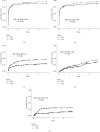Long-Term Infectious and Noninfectious Outcomes of Monthly Alemtuzumab as a Calcineurin Inhibitor- and Steroid-Free Regimen for Pancreas Transplant Recipients
- PMID: 33101558
- PMCID: PMC7569440
- DOI: 10.1155/2020/8883183
Long-Term Infectious and Noninfectious Outcomes of Monthly Alemtuzumab as a Calcineurin Inhibitor- and Steroid-Free Regimen for Pancreas Transplant Recipients
Abstract
Multiple doses of alemtuzumab for immunosuppressive therapy of patients with hematologic malignancies and hematopoietic stem cell transplant have been associated with a high rate of infection. In transplantation, limited alemtuzumab dosing has been successfully used as induction immunosuppression. The effect of multiple doses of alemtuzumab, used as maintenance therapy to minimize steroid and/or calcineurin inhibitor toxicity in solid organ transplant recipients, is unknown. We evaluated the infectious and noninfectious outcomes of 179 pancreas transplant recipients treated with alemtuzumab for induction and maintenance therapy (extended alemtuzumab exposure (EAE)) from 2/28/2003 through 8/31/2005, compared with 159 pancreas transplant recipients with standard induction and maintenance (SIM) therapy performed before (1/1/2002 until 12/31/2002) and after (1/1/2006 until 12/31/2006) the implementation of EAE. EAE was associated with higher risk of overall infections (hazard ratio (HR) 1.33 (1.06-1.66), P=0.01), bacterial infections (HR 1.33 (1.05-1.67), P=0.02), fungal infections (HR 1.86 (1.28-2.71), P < 0.01), and cytomegalovirus infections (HR 2.29 (1.39-3.77), P < 0.01). In addition, EAE was associated with higher risk of acute cellular rejection (HR 2.09 (1.46-2.99), P < 0.01). In conclusion, while a limited alemtuzumab dosing is safe and effective for induction therapy in pancreas transplantation, EAE combined with steroid and calcineurin minimization is associated with a high risk of infectious complications and acute cellular rejection.
Copyright © 2020 Adam Kaplan et al.
Conflict of interest statement
The authors declare that they have no conflicts of interest.
Figures




Similar articles
-
Influence of induction modality on the outcome of deceased donor kidney transplant recipients discharged on steroid-free maintenance immunosuppression.Transplantation. 2012 Apr 27;93(8):799-805. doi: 10.1097/TP.0b013e3182472898. Transplantation. 2012. PMID: 22290269
-
Alemtuzumab induction in deceased donor kidney transplantation.Transplant Proc. 2011 Jul-Aug;43(6):2365-78. doi: 10.1016/j.transproceed.2011.05.032. Transplant Proc. 2011. PMID: 21839271
-
Fungal infections in transplant recipients receiving alemtuzumab.Transplant Proc. 2005 Mar;37(2):934-6. doi: 10.1016/j.transproceed.2005.01.054. Transplant Proc. 2005. PMID: 15848579
-
Alemtuzumab for cytolytic induction of immunosuppression in heart transplant recipients.Prog Transplant. 2012 Dec;22(4):344-9; quiz 350. doi: 10.7182/pit2012241. Prog Transplant. 2012. PMID: 23187050 Review.
-
Alemtuzumab (Campath-1H) experience in kidney transplantation what we have learned; current practices; and scope for the future?Curr Opin Organ Transplant. 2015 Dec;20(6):638-42. doi: 10.1097/MOT.0000000000000255. Curr Opin Organ Transplant. 2015. PMID: 26536426 Review.
Cited by
-
Immunopathology of lung transplantation: from infection to rejection and vice versa.Front Immunol. 2024 Sep 2;15:1433469. doi: 10.3389/fimmu.2024.1433469. eCollection 2024. Front Immunol. 2024. PMID: 39286256 Free PMC article. Review.
-
Alemtuzumab for haematological malignancies.Ann Hematol. 2025 May;104(5):2593-2603. doi: 10.1007/s00277-025-06344-8. Epub 2025 Apr 11. Ann Hematol. 2025. PMID: 40214729 Free PMC article. Review.
-
Daily Fungal Cell-Free DNA Testing to Assess Clinical Status during Candida krusei Fungemia.J Fungi (Basel). 2024 Jun 27;10(7):449. doi: 10.3390/jof10070449. J Fungi (Basel). 2024. PMID: 39057334 Free PMC article.
References
-
- Bertz H., Spyridonidis A., Wasch R., Grullich C., Egger M., Finke J. A novel GVHD-prophylaxis with low-dose alemtuzumab in allogeneic sibling or unrelated donor hematopoetic cell transplantation: the feasibility of deescalation. Biology of Blood and Marrow Transplantation. 2009;15(12):1563–1570. doi: 10.1016/j.bbmt.2009.08.002. - DOI - PubMed
-
- Busemann C., Neumann T., Schulze M., et al. Low-dose alemtuzumab vs. standard policy for prevention of graft-versus-host disease in unrelated and related allogeneic stem cell transplantation-a matched pair analysis. Annals of Hematology. 2013;92(7):945–952. doi: 10.1007/s00277-013-1714-4. - DOI - PubMed
LinkOut - more resources
Full Text Sources

